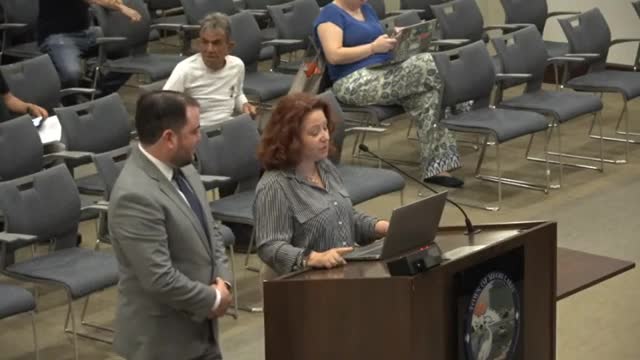Miami Lakes Council debates rezoning for 10 properties amid resident concerns
May 22, 2025 | Miami Lakes, Miami-Dade County, Florida
This article was created by AI summarizing key points discussed. AI makes mistakes, so for full details and context, please refer to the video of the full meeting. Please report any errors so we can fix them. Report an error »

The Regular Council Meeting held on May 20, 2025, in Miami Lakes, Florida, focused on a significant rezoning proposal affecting a neighborhood comprising ten properties along Northwest 70 Fourth, 140 Fourth, 140 Fifth, and 140 Third Streets. The primary objective of the meeting was to transition the area from General Use (GU) zoning to Residential Use 1 (RU 1) zoning, aligning it with the town's comprehensive plan that designates the area for low-density residential development.
The discussion began with a presentation outlining the need for the rezoning, emphasizing that the current GU designation lacks clear regulations, which complicates property development and maintenance. The proposed RU 1 zoning would provide property owners with defined standards for setbacks, building permits, and development rights, fostering a more orderly development process.
However, the proposal faced opposition from several residents who expressed concerns about potential overcrowding and the loss of the neighborhood's character. Many residents argued that the existing GU zoning has allowed them to maintain a peaceful, low-density environment, and they feared that transitioning to RU 1 could lead to increased density and traffic. They highlighted that their community has functioned well under the current zoning, which has preserved its unique character for decades.
Supporters of the rezoning, including property owners seeking to build homes, argued that the change is necessary to facilitate development and provide clarity for future homeowners. They pointed out that the current zoning has created hardships for new buyers who are unable to obtain building permits due to the ambiguous regulations associated with GU zoning.
During the public comment period, various residents voiced their opinions, with some advocating for the preservation of the existing zoning to protect their lifestyle and property rights. Others suggested exploring the creation of a historic district or overlay that would allow for the preservation of the neighborhood's character while still enabling new construction under specific guidelines.
As the meeting progressed, council members engaged in a thorough discussion about the implications of the rezoning, weighing the benefits of clearer regulations against the residents' concerns about maintaining the area's character. The council ultimately decided to table the matter indefinitely, directing staff to explore the possibility of establishing a historic district or overlay that would allow existing property owners to retain their current uses while accommodating new development in a manner that respects the neighborhood's character.
The meeting concluded with a commitment to further investigate options that would balance the needs of current residents with the interests of potential new homeowners, ensuring that any future decisions align with the community's values and the town's comprehensive plan.
The discussion began with a presentation outlining the need for the rezoning, emphasizing that the current GU designation lacks clear regulations, which complicates property development and maintenance. The proposed RU 1 zoning would provide property owners with defined standards for setbacks, building permits, and development rights, fostering a more orderly development process.
However, the proposal faced opposition from several residents who expressed concerns about potential overcrowding and the loss of the neighborhood's character. Many residents argued that the existing GU zoning has allowed them to maintain a peaceful, low-density environment, and they feared that transitioning to RU 1 could lead to increased density and traffic. They highlighted that their community has functioned well under the current zoning, which has preserved its unique character for decades.
Supporters of the rezoning, including property owners seeking to build homes, argued that the change is necessary to facilitate development and provide clarity for future homeowners. They pointed out that the current zoning has created hardships for new buyers who are unable to obtain building permits due to the ambiguous regulations associated with GU zoning.
During the public comment period, various residents voiced their opinions, with some advocating for the preservation of the existing zoning to protect their lifestyle and property rights. Others suggested exploring the creation of a historic district or overlay that would allow for the preservation of the neighborhood's character while still enabling new construction under specific guidelines.
As the meeting progressed, council members engaged in a thorough discussion about the implications of the rezoning, weighing the benefits of clearer regulations against the residents' concerns about maintaining the area's character. The council ultimately decided to table the matter indefinitely, directing staff to explore the possibility of establishing a historic district or overlay that would allow existing property owners to retain their current uses while accommodating new development in a manner that respects the neighborhood's character.
The meeting concluded with a commitment to further investigate options that would balance the needs of current residents with the interests of potential new homeowners, ensuring that any future decisions align with the community's values and the town's comprehensive plan.
View full meeting
This article is based on a recent meeting—watch the full video and explore the complete transcript for deeper insights into the discussion.
View full meeting